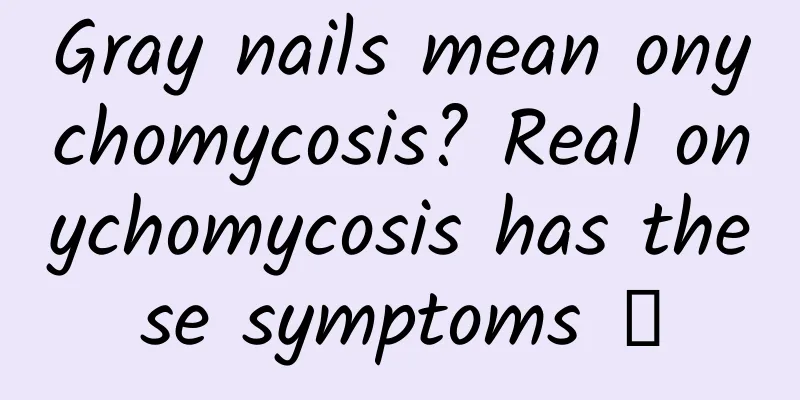Gray nails mean onychomycosis? Real onychomycosis has these symptoms →

|
Author: Tang Jiaoqing, attending physician of dermatology, doctor of medicine, popular science author Reviewer: Chen Haixu, Deputy Director of PLA General Hospital (301 Hospital), Postgraduate Supervisor gossip Speaking of onychomycosis, I guess you should have two understandings of it: The first one is the popular advertising slogan: If you have onychomycosis, one person can infect two others. The subtext is that onychomycosis is contagious and can be transmitted from one nail to another. Secondly, onychomycosis means "nails that turn gray." Therefore, many people think that gray nails mean they have onychomycosis . Is this really the case? analyze Why is it called "Onychomycosis"? In fact, "onychomycosis" is a common name for nail fungal infection. Copyrighted stock images, no reproduction is authorized This common name is actually rather one-sided and can easily lead to misunderstandings, as people mistakenly think that the nails are just graying. In fact, it more often refers to the fact that after fungal infection, the nails will become grayish white, dull, or the transparency of the nails will change, appearing turbid and opaque. In medicine, nail fungal infections such as "onychomycosis" are called " onychomycosis " or " onychomycosis ". There are many similar inaccurate slang names. For example, "athlete's foot" may make people think that it means that the feet have a bad smell, or that it is foot odor. In fact, athlete's foot refers to a fungal infection of the feet, which can be transmitted to onychomycosis, and they are "brothers in distress". The main characteristics of athlete's foot are not the smell, but the symptoms of rotten feet (soft, white, and damaged toes), skin blisters, and itching. Another example is "fat granules", which may make people think that it is the increase of fat caused by the nutrition process. In fact, fat granules are structural changes formed after the skin is blocked, which belongs to the category of cysts. They have nothing to do with the nutrition process or the increase of fat, and have little to do with the high-quality and expensive skin care products used in daily life. What are the symptoms of true onychomycosis? You may also be curious about what the symptoms of true onychomycosis are? Basically, the main characteristic of onychomycosis is that the nails are damaged to varying degrees. This is because after the fungus invades the nails, it takes it as its home. They use the keratin in the nails as food, nibbling away at the keratin every day, and continue to multiply and expand their territory. Copyrighted stock images, no reproduction is authorized Specifically, if you have onychomycosis, your diseased nails may have the following symptoms: Thickening : The nail is originally a very dense keratinized structure. After being tossed around by fungi, the nail continues to thicken, just like a book that has been repeatedly flipped through. Discoloration : It can turn white, yellow or brown, which is related to factors such as changes in nail structure, the production of nail debris and powder, and changes in refractive index. Fragile, brittle or rough : When nails become infected, they lose some of their protective function in the later stages, becoming easily broken, brittle, and having a rough surface. Deformity : Over time, the nails will no longer be beautiful and their shapes will change in various ways, each with its own ugly appearance. Peeling : Separation from the nail bed is also a manifestation of onychomycosis, which means that the nail cap and the finger underneath do not fit well and a gap appears. Stinky : Don’t get close to smell your nails or nail crumbs. Sometimes they can really stink and can leave people with psychological trauma. Pain : Sometimes deformed nails squeeze the surrounding skin or even cause paronychia, which may cause pain. As can be seen from the above, the symptoms of onychomycosis are quite complex and cannot be simply summarized by the word "gray". However, you don’t have to take it for granted, because everyone’s onychomycosis will grow differently and will be affected by many factors. For example, onychomycosis that has not been treated for many years is more likely to become noticeably thickened and deformed, and sometimes the nail will be completely destroyed and become unrecognizable; if it is an early stage onychomycosis, it may just be a line or a small patch of turbidity. These gray nails are not onychomycosis In addition, there are several types of nails that turn gray, which can easily be mistaken for onychomycosis. Be sure to avoid this pitfall. One of them is the common " activation of nail melanocytes ", which in plain words is actually the pigmentation of nails . This is how it happens - there are melanocytes at the root of the nail where the nail grows. Under normal circumstances, melanin is not over-produced, but if there are factors such as inflammation or injury, such as eczema, frequent squeezing and collision, the melanocytes can release these particles under stimulation, causing pigmentation. Over time, pigmentation can grow with the nail, making it look dull, gray, or even black, like a pencil mark that can't be erased. Another is subungual bleeding , which is usually temporary bleeding caused by accidental external forces, such as climbing a mountain, running, wearing high heels, or kicking a small stone. After bleeding, blood clots will accumulate under the nail. If you don't pay attention, you may think it is onychomycosis. If you look closely, there is nothing wrong with the nail itself, and the black blood clot will slowly move to the end of the finger with the nail, and disappear after a few months. After saying so much, I wonder if you can tell which ones are real onychomycosis? If you suspect you have onychomycosis, it is recommended that you seek medical attention. Doctors have many ways to confirm the diagnosis. Do not self-diagnose or take medication, and do not trust the pedicure doctor. Copyrighted stock images, no reproduction is authorized in conclusion Graying of nails is not necessarily caused by onychomycosis. Nails can also turn gray due to activation of nail melanocytes and subungual bleeding. In case of real onychomycosis, the nail will be damaged to various degrees, which may manifest as nail thickening, discoloration, deformity, peeling, odor, pain, etc. Source: Starry Sky Project This article is produced by Science Popularization China-Starry Sky Project (Creation and Cultivation). Please indicate the source when reprinting. The cover image and images within this article are from the copyright gallery. Reprinting and quoting them may lead to copyright disputes. |
<<: Can magnets also be used for cooling? Amazing black technology cooling technology!
Recommend
Don’t ask! Milk tea is for afternoon drinking, people go crazy at night!
Who is the “traffic leader” in the beverage indus...
iOS Translucent Beginner's Guide to Teaching You How to Make It
1. Effect display [[142842]] This type of novice ...
Omnichannel Promotion | How to find an effective user interaction strategy?
With the development of technological trends, a c...
Popular Science Online | Deciphering the five greatest facts about stem cells: Why are they the source of human life?
The wrinkles that quietly grow at the corners of ...
What kind of rice is the "rice" in Travel Companion's "self-heating rice"?
During holidays, people often encounter inconveni...
World Tiger Day丨The eternal question: Who will win in a fight between a tiger and a lion?
July 29th of every year is World Tiger Day. How m...
Eat a little of it every day to nourish your brain, protect your eyes and skin! You can do it in just 2 steps!
As early as the 1940s, people found that the Eski...
Light-induced molecular vibrations cause cancer cells to burst! |Science Daily
01 Eliminating antibiotic-resistant “superbugs” A...
How does this little pill make men fall step by step?
Sildenafil acts directly on blood vessels and can...
The secret of hybrid fuel saving: in-depth technical interpretation of eCVT transmission
You may have noticed that many common hybrid mode...
These gadgets can make your Android phone more useful
Many people say that Android is not as good as iPh...
How to be creative with your Chinese Valentine’s Day brand posters? Try these tips
The Chinese Valentine's Day is coming, and pe...
Short video marketing, save these strategies quickly!
In recent years, with the sharp increase in deman...
"China's Sky Eye" has made new discoveries!
The "China Sky Eye" has made new discov...









